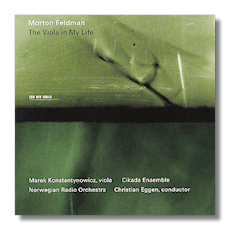
The Internet's Premier Classical Music Source
Related Links
- Feldman Reviews
- Latest Reviews
- More Reviews
-
By Composer
-
Collections
DVD & Blu-ray
Books
Concert Reviews
Articles/Interviews
Software
Audio
Search Amazon
Recommended Links
Site News
 CD Review
CD Review
Morton Feldman

The Viola in My Life
- The Viola in My Life I 1
- The Viola in My Life II 2
- The Viola in My Life III 3
- The Viola in My Life IV 4
Marek Konstantynowicz, viola
1-2 Cikada Ensemble
3 Kenneth Karlsson, piano
4 Norwegian Radio Orchestra/Christian Eggen
ECM New Series 1798 (4765777) DDD 39:39
These four works were written between August 1970 and March 1971, more or less back to back. Earlier in his career, Feldman (then known as a Cage disciple) wrote music in which indeterminacy (of pitch, of tempo, etc.) played a central role. The Viola in My Life is of signal importance as it marked a change in Feldman's style as a composer – that is to say, here he reclaimed and specified everything. I leave it up to others to connect this change (or not) to the fact that these works are among his most gorgeous – akin to Rothko Chapel, which came along in 1971.
Hearing The Viola in My Life is like viewing a sculpture from many different perspectives. Pitches appear and reappear, but in ever-changing contexts. The music moves slowly, in what seems to be a kind of random Brownian motion, until we are caught short and realize that we have been carried far from where we started after all. Some listeners have the impression, when confronted with Feldman's music, that they are listening to a manuscript that has been recovered from the bottom of the ocean, and that is riddled with multiple holes, both large and small. In other words, it can seem like a music of absences. Feldman probably would have bristled at such an analogy, however. He took great care to create complete worlds in his music, and The Viola in My Life (sometimes spare, sometimes full and vibrant, but never deficient or in excess) is one of his most successful efforts.
Oddly, this might be the first time that all four works have been released together. A New World disc – formerly CRI – includes the first three, and one from Ensemble Recherche includes the first two. (The CRI disc reverses the order of the first two works without reversing the titles; I don't know if this error was corrected by New World.) The violist in Feldman's life was Karen Phillips, and she can be heard on the former recording, which dates from 1970 and is conducted by the composer. That's pretty authentic, obviously. The ECM New Series performances are faster than those in either of the aforementioned recordings. As a result, they are more sensual and have greater momentum. I am not sure that Feldman would have liked that. I don't think it does the music any violence, however. On the other hand, I think Feldman would have liked the overall sound of these Norwegian readings, which seem to hang on the edge of darkness. Feldman often insisted that his music should be played very softly. These new versions capture the spirit of that direction most closely, although I confess that it is tempting to turn up the volume, because they are so beautiful, and recorded so warmly.
Paul Griffiths' booklet note is, as usual, more interesting than most. My only complaint is that 39:39 is awfully short for a full-priced CD.
Copyright © 2008 by Raymond Tuttle




















